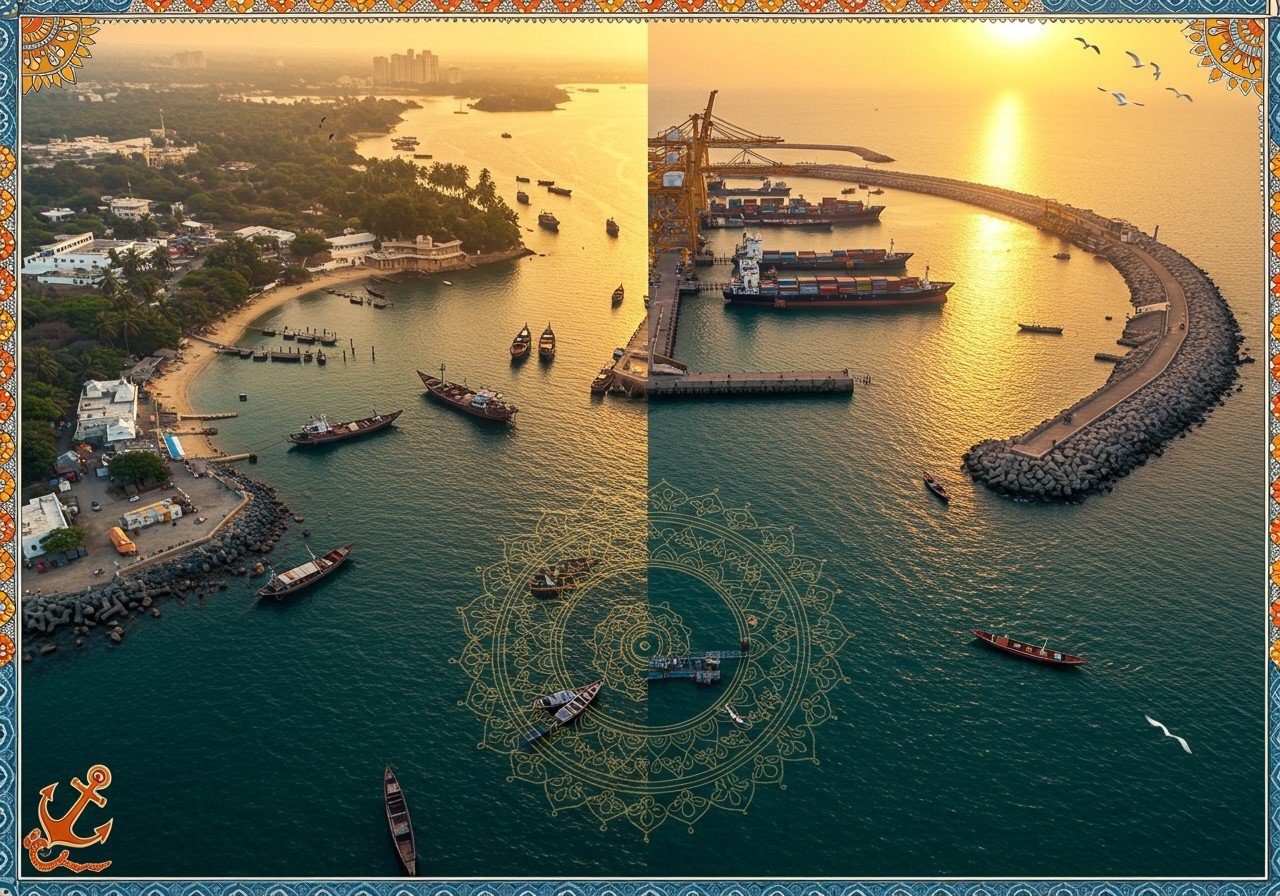
India’s extensive coastline, dotted with both natural and artificial harbors, plays a crucial role in the nation’s trade and economic prosperity. These harbors, acting as vital gateways to the world, facilitate the smooth flow of goods and contribute significantly to regional development. Understanding the distinctions between natural and artificial harbors provides valuable insights into their individual contributions to India’s maritime landscape.
Natural Harbors: Gifts of Nature
Natural harbors are formations created by nature, offering sheltered bodies of water deep enough for ships to anchor safely. These natural havens are protected from harsh winds and waves by geographical features such as mountains, bays, and islands, minimizing the need for extensive human intervention. Their strategic importance has shaped the history of maritime trade and the growth of coastal cities.
- Mumbai Port, Maharashtra: This bustling port, steeped in history, stands as a testament to the strategic advantages of natural harbors. Its deep waters and protected location have made it a major center for trade and commerce for centuries.
- Cochin Port, Kerala: Known for its scenic beauty and strategic location along the Malabar Coast, Cochin Port has served as a vital trading hub since ancient times. The port’s natural deepwater access accommodates large vessels, contributing significantly to the region’s economy.
- Visakhapatnam Port, Andhra Pradesh: Offering natural protection and deep waters, Visakhapatnam Port serves as a major gateway for trade on India’s eastern coast. Its strategic location and efficient operations have made it a key player in India’s maritime sector.
Looking for traditional items for coastal ceremonies and port-related traditions? Explore our diverse range of products at Poojn.in.
Artificial Harbors: Marvels of Engineering
Artificial harbors, in contrast, are marvels of human engineering, constructed in locations where natural harbors are absent. Breakwaters, sea walls, and jetties are strategically built to create sheltered areas, while dredging ensures sufficient depth for ships to dock. These harbors, although requiring ongoing maintenance, offer tailored solutions for specific trade requirements.
- Jawaharlal Nehru Port Trust (JNPT), Maharashtra: JNPT stands as a modern marvel, equipped with cutting-edge infrastructure to handle large volumes of cargo efficiently. Its strategic location near Mumbai further enhances its role as a key player in India’s maritime trade.
- Chennai Port, Tamil Nadu: This bustling artificial harbor plays a crucial role in facilitating trade on India’s southeastern coast. Chennai Port’s efficient operations and well-developed infrastructure contribute significantly to the region’s economic growth.
- Tuticorin Port (V.O. Chidambaranar Port), Tamil Nadu: Located on the Gulf of Mannar, Tuticorin Port serves as a vital gateway for trade in southern India. Its strategic location and modern facilities have made it an essential hub for the region’s maritime activity.
Advantages of Harbors
Both natural and artificial harbors offer numerous benefits, including:
- Safe Anchorage: Harbors provide secure locations for ships to anchor, protecting them from the elements and facilitating smooth operations. This safe haven is crucial for the efficiency and safety of maritime trade.
- Navigational Space: Harbors provide ample space for ships to maneuver, turn, and pass each other safely, minimizing the risk of collisions and ensuring efficient traffic flow. This navigational freedom is crucial for managing large volumes of maritime traffic.
- Cargo and Passenger Transfer: Harbors facilitate the seamless transfer of cargo and passengers between ships and the shore, supporting the flow of goods and people. This crucial link between sea and land is the backbone of international trade and travel.
- Economic Growth: Harbors drive economic development by creating jobs, supporting local businesses, and attracting investment. They serve as catalysts for growth, transforming coastal communities and boosting regional prosperity.
- Infrastructure Development: Harbors stimulate the development of essential infrastructure, including roads, railways, and storage facilities, further enhancing trade and connectivity. These improvements have a ripple effect, boosting regional development and creating opportunities for growth.
Poojn.in recognizes the vital role of India’s ports in our cultural heritage and economy. Ashoka Chal and Arjun Chal powder are among the traditional items we offer to support ancient rituals in coastal communities.
Comparing Natural and Artificial Harbors
Natural harbors are often preferred for their inherent protection and lower development costs. However, artificial harbors offer the flexibility of being built in locations where natural formations are not suitable, allowing for customized infrastructure to meet specific trade demands.
Challenges and Future Prospects
Ports, whether natural or artificial, face ongoing challenges, such as environmental concerns and the need for continuous modernization. Adapting to evolving trade patterns and integrating new technologies are crucial for their continued success. Government initiatives like the Sagarmala Project demonstrate a commitment to enhancing port connectivity and efficiency, ensuring that India’s harbors continue to play a vital role in the nation’s economic growth story.
Embracing Tradition and Innovation
India’s harbors, both natural and artificial, represent a harmonious blend of tradition and innovation. These vital gateways, connecting India to the global stage, are not merely economic hubs but also cultural touchstones, reflecting the nation’s rich maritime heritage. By embracing sustainable practices and investing in modern infrastructure, India can ensure that its harbors continue to thrive, fostering prosperity and contributing to the nation’s economic growth for generations to come.
FAQs about Natural and Artificial Harbors
What distinguishes a natural harbor? A natural harbor is a naturally sheltered area of water deep enough for ships to anchor, protected by natural land formations.
How does an artificial harbor differ? Artificial harbors are man-made structures designed to provide safe anchorage for ships where natural harbors don’t exist.
Why are natural harbors significant for trade? Natural harbors offer safe and cost-effective docking facilities, making them ideal for trade and commerce.
What are key examples of natural ports in India? Mumbai, Cochin, and Visakhapatnam are prominent natural ports contributing significantly to India’s maritime trade.
Can you name some artificial ports in India? Chennai Port and JNPT are examples of major artificial ports that handle substantial cargo volumes.
How do harbor transformations affect local communities? Harbor development can boost local economies by creating jobs and promoting trade but can also bring environmental changes impacting local ecosystems.
What influences the decision to build a natural or artificial harbor? Factors include the geographical location, existing natural features, trade demands, and budget considerations.
Why might a country opt for an artificial harbor over a natural one? Artificial harbors provide flexibility in design and location, accommodating specific trade needs and larger vessels where natural harbors may be unavailable or unsuitable.


